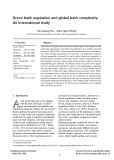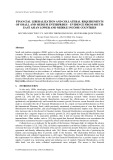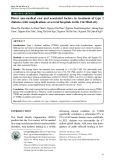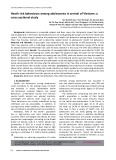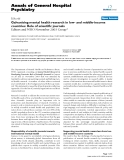
Middle income country
-
This study investigates the relationship between green bank regulation and global bank geographic complexity using data from 121 countries spanning the period 1996 to 2021. By examining the affiliate networks of internationally active banking organizations, we construct a comprehensive measure of bank geographic complexity for each country.
 16p
16p  viinuzuka
viinuzuka
 28-02-2025
28-02-2025
 2
2
 1
1
 Download
Download
-
In addition to financial liberalization - our main explanatory variable, we control other factors which may affect SMEs’ collateral requirements such as country and firm characteristics. The main result shows that financial liberalization increases the likelihood of collateral requirements.
 15p
15p  vimarillynhewson
vimarillynhewson
 02-01-2024
02-01-2024
 7
7
 2
2
 Download
Download
-
Valsartan, an angiotensin blocker, is often combined with amlodipine (a calcium channel antagonist) in the current treatment of hypertension. There is a generic brand-name drug Exforge® which has been proven to be clinically effective. However, its price is high, making it quite difficult to access, especially in low- and middle-income countries. Therefore, research and development of generic drugs is essential.
 7p
7p  vinara
vinara
 11-01-2025
11-01-2025
 1
1
 1
1
 Download
Download
-
Type 2 diabetes mellitus (T2DM), especially those with complications, requires lifelong care and incurs substantial expenses. In order to reduce out-of-pocket costs borne by patients, understanding costs including direct non-medical cost is important. This study aims to examine direct non-medical cost and related factors among T2DM with complications.
 9p
9p  vihatake
vihatake
 06-01-2025
06-01-2025
 5
5
 2
2
 Download
Download
-
Adolescence is vulnerable subjects and faces many risks that greatly impact their health and development in the future, but adolescents are not really getting the proper care from the health care system. This study aimed to examine the prevalence of health risk behaviours among adolescents in Thua Thien Hue Province, Vietnam, and to determine related factors to adolescents’ health risk behaviours.
 8p
8p  viharuno
viharuno
 03-01-2025
03-01-2025
 3
3
 2
2
 Download
Download
-
According to the ASEAN Consumer Survey conducted by HKTDC Research, ASEAN consumers, including those in Thailand, are willing to spend more on better quality products and have a strong sense of personal style. For international brands, Thailand is a key market among the developing Asian countries, not only because of its growing demand from the emerging middle-income class, but also the country’s flourishing tourism sector. Also, Thailand is a South East Asian country with close proximity to Vietnam.
 42p
42p  chophen123
chophen123
 02-02-2021
02-02-2021
 60
60
 10
10
 Download
Download
-
The Official Development Assistance (ODA) in the thesis includes the grant aid, concessional loans, the less concessional loans from the governments and international financial institutions.
 12p
12p  change01
change01
 05-05-2016
05-05-2016
 80
80
 3
3
 Download
Download
-
Tuyển tập các báo cáo nghiên cứu về y học được đăng trên tạp chí y học quốc tế cung cấp cho các bạn kiến thức về ngành y đề tài: Trauma research in low- and middle-income countries is urgently needed to strengthen the chain of survival
 8p
8p  toshiba18
toshiba18
 31-10-2011
31-10-2011
 84
84
 1
1
 Download
Download
-
Tuyển tập các báo cáo nghiên cứu về y học được đăng trên tạp chí y học General Psychiatry cung cấp cho các bạn kiến thức về ngành y đề tài: Galvanising mental health research in low- and middle-income countries: Role of scientific journals...
 4p
4p  thulanh10
thulanh10
 09-10-2011
09-10-2011
 57
57
 4
4
 Download
Download
CHỦ ĐỀ BẠN MUỐN TÌM









